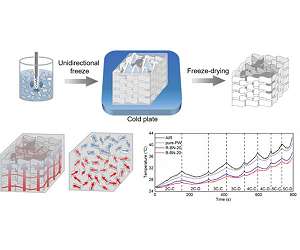Scientists in Japan have found a common substance that can reversibly and rapidly store and release relatively large amounts of low-grade heat without decomposing. The research could lead to more efficient reuse of industrial waste heat.
The results were published in the journal Nature Communications and were a collaboration between scientists at Tohoku University’s Institute for Materials Research and Rigaku Corporation, a company that designs and manufactures X-ray-based measurement and thermal analysis tools.
In their investigations, the researchers used a layered manganese oxide mineral containing potassium ions and crystal water. This mineral is quite similar in its composition to birnessite, which is commonly found on the Earth’s surface.
The team fabricated their compound in the form of an insoluble black powder and then examined its crystal structure using an X-ray diffractometer and a transmission electron microscope. They then examined how the compound’s structure changed when heated or cooled, and how much and how quickly heat energy was stored and released.
Heating the material up to 200C dehydrated it by giving its stored water molecules the energy they need to be released into the surrounding atmosphere. When the dehydrated material was then cooled below 120C in a dry container and then exposed to humid air, it absorbed water molecules and released its stored heat.
“This ‘intercalation’ mechanism, where water molecules are reversibly inserted into a layered material, is very advantageous for heat storage,” says Tohoku University materials scientist Tetsu Ichitsubo.
“It is very fast, reversible and the material’s structure is well maintained. Also, oxygen in the atmosphere doesn’t degrade the layered manganese oxide crystal and water doesn’t dissolve it. This makes it an excellent candidate for waste-heat reuse in industrial settings.”
This ‘birnessite-type layered manganese dioxide with crystal water’ compound demonstrated better all-round performance compared to other compounds currently being researched for heat storage purposes. “Our material has a long lifetime, can reversibly store and release large amounts of heat per unit volume, and rapidly charges and discharges,” says Ichitsubo.
The researchers validated the results of their experiments with theoretical calculations.
Next, they plan to work on increasing the amount of water molecules that can be accommodated by the material in order to increase the amount of heat energy it can store.
“Excellently balanced water-intercalation-type heat-storage oxide”
Related Links
Tohoku University
Powering The World in the 21st Century at Energy-Daily.com
|
We need your help. The SpaceDaily news network continues to grow but revenues have never been harder to maintain. With the rise of Ad Blockers, and Facebook – our traditional revenue sources via quality network advertising continues to decline. And unlike so many other news sites, we don’t have a paywall – with those annoying usernames and passwords. Our news coverage takes time and effort to publish 365 days a year. If you find our news sites informative and useful then please consider becoming a regular supporter or for now make a one off contribution. |
||
|
SpaceDaily Contributor $5 Billed Once credit card or paypal |
SpaceDaily Monthly Supporter $5 Billed Monthly paypal only |
|

![]()
New 3D thermal management network could increase the safety of electric car batteries
Hangzhou, China (SPX) Mar 30, 2022
While electric vehicles have reaped the rewards of new high-energy lithium-ion batteries and rapid charging technology, challenges remain.
For example, although cars can cover longer distances between charges, and battery charging times have reduced, the lifespan of those batteries has also decreased, and low heat dissipation efficiency has led to safety issues.
Researchers from the US and China set out to find an economic but efficient battery thermal management strategy to keep battery tem … read more
